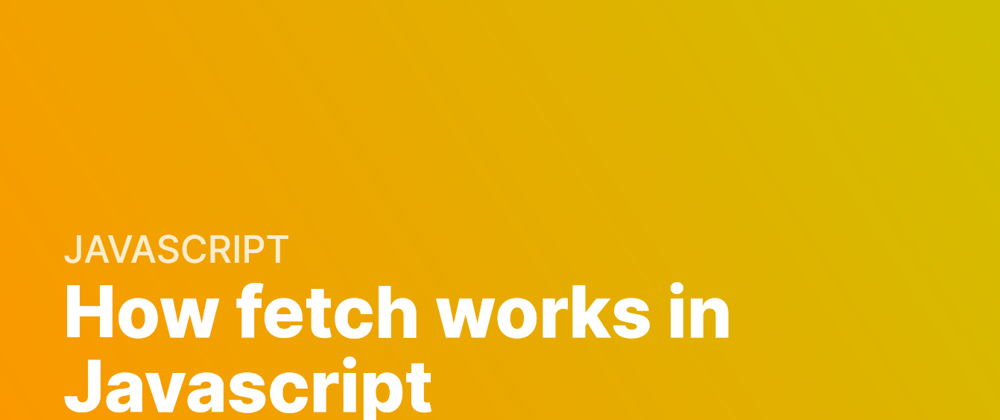If we want to get data from an API, or post data to a server, we have to use the fetch API. As is implied by the name, fetch() gives us a way to send and receive HTTP requests through requests and responses.
The fetch() function is a global function, and it is most frequently used to interact with APIs. If you're new to it, you're not alone - so let's take a look at how fetch() works.
How to use fetch in Javascript
The most basic use of fetch takes one argument - the URL we want to fetch. When we run fetch, it returns a response:
let fetchExample = fetch("https://fjolt.com").then((res) => {
// Do something with res
});
The cool thing is res has a bunch of built in functions:
-
res.text()- returns the text content of a URL. If it's a website, it returns the HTML. -
res.json()- returns formatted JSON data, if it exists. -
res.blob()- returns blob data, if any exists. -
res.arrayBuffer()- returns arrayBuffer data, if any exists. -
res.formData()- returns formData data, if any exists. Let's look at two examples, to show how this works.
Get HTML Content of a Website using Javascript Fetch
Since res.text() gives us the text content of a URL, we can use it to get the entire HTML content of a site. Once we run res.text(), we can catch the response with another then, and console log it:
let websiteData = fetch("https://fjolt.com").then(res => res.text()).then((data) => {
return data;
});
// Now contains our website's HTML.
If the link doesn't exist, or an error occurs, our response object will return an error. For example, a page not found will return 404, or a bad gateway error will return 502.
Get JSON Content from a Link using Javascript Fetch
Another common use of fetch is to get the response of an array. If we want to get the response from an API formatted in JSON, we can use the res.json(). For example, the following code will return a JSON object from the URL, assuming the URL is sending valid JSON back:
let apiResponse = fetch("https://fjolt.com/api").then(res => res.json()).then((data) => {
return data;
});
// Now contains a JSON object - assuming one exists
Options for Javascript Fetch
Since fetch sends and receives HTTP requests, it has a lot of options we can use with it, as well as the URL. They come after the URL, as an object - i.e. fetch(URL, { options }). If you've worked with HTTP requests before, some may be familiar. An example of all options available are shown below:
fetch("https://fjolt.com/", {
body: JSON.stringify({ someData: "value" })
method: 'POST'
mode: 'cors'
cache: 'no-cache'
credentials: 'same-origin'
headers: {
'Content-Type': 'application/json'
},
redirect: 'follow'
referrerPolicy: 'no-referrer'
});
Here is a summary of what each of these mean:
-
body contains the body of the text. In this example, we are sending some JSON, which needs to be stringified.
method is a standard HTTP method. It can be
POST/GET/DELETE/PUT/CONNECT/PATCH/TRACE/OPTIONS. -
mode refers to if cross origin requests are accepted. It can be
cors/no-cors/same-origin. -
cache refers to how the browser will interact with the cache. It can be
default/no-cache/reload/force-cache/only-if-cached. -
credentials refers to if cross origin cookies should be sent with the request. It can be
include/same-origin/omit. headers contains any header associated with the request. It can contain any HTTP header - for example, here it shows -Content-Type- but you can have custom HTTP headers too. redirect determines what happens if the fetched URL redirects. It can befollow/error/manual. -
referrerPolicy determines how much referrer information is passed with the request. It can be
no-referrer/no-referrer-when-downgrade/origin/origin-when-cross-origin/same-origin/strict-origin/strict-origin-when-cross-origin/unsafe-url.
Javascript Fetch is asynchronous
When we use fetch, it goes off to the URL we defined, gathers the information, and brings a response back to us. This is not immediate, since loading the URL and bringing it back takes time. If we simply run fetch alone, the console log will return a Promise, not the response from the URL we want:
let apiResponse = fetch("https://fjolt.com/api");
console.log(apiResponse); // Returns Promise<Pending>
This happens because the fetch() function runs, but Javascript doesn't wait for the response. As such, we have to explicitly tell Javascript to wait for it, if we want to access the response.
There are two ways to wait for fetch():
- We can use then, and manipulate the response of our fetch() in the then loop.
- We can use await, and wait for the fetch to return before using its contents.
Using then to wait for a fetch in Javascript
One way to access data from a fetch() call is to chain then onto our fetch, allowing us to access the response from our URL. The contents of fetch() can be manipulated within the then() callback function, but not outside of it. For example:
let apiResponse = fetch("https://fjolt.com/api").then(res => res.json()).then((data) => {
console.log(data);
// We can do anything with the data from our api here.
return data;
});
console.log(apiResponse); // This will return Promise<Pending>
// That means we can't use the apiResponse variable
// outside of the then() function.
If we want to use the contents from fetch() outside of a then function, we have to use await.
Using await to wait for a fetch in Javascript
The other way to wait for a fetch is to use the await keyword. Most modern browsers support Top level awaits, but if you are concerned about support, or using a version of Node.JS before 14.8, you'll want to wrap any await code within an async function.
If we use await, we can use the response from our API anywhere in our function or code, and use any response functions, like text() or json() on it. For example:
// Typically we wrap await in an async function
// But most modern browsers and Node.JS support
// await statements outside of async functions now.
async getAPI() {
let apiResponse = await fetch("https://fjolt.com/api");
let response = apiResponse.json();
// Since we waited for our API to respond using await
// The response variable will return the response from the API
// And not a promise.
console.log(response);
}
getAPI();
If you want to learn more about async operations, read my tutorial on asynchronous Javascript here.
Conclusion
In this guide, we've gone through how fetch works. We've shown the different options you can send with your fetch() requests, and how to wait for the response using asynchronous concepts in Javascript. fetch() is an incredibly powerful tool in Javascript, and is used frequently in big products all the time. I hope you've enjoyed this article.







Top comments (1)
Really well written, I’ve just started using fetch more and more and this is a great overview. It helped crystallize some of the main concepts for me.